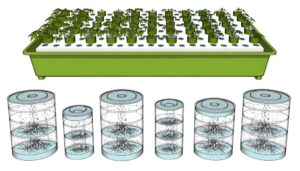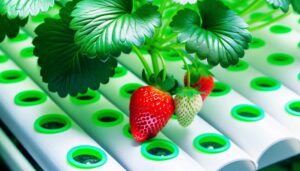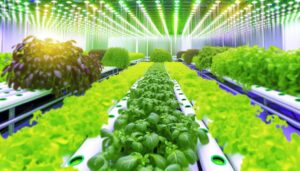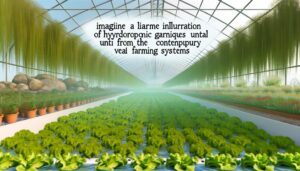What Are the Advantages of Hydroponics
We're observing numerous advantages in hydroponics, including accelerated plant growth due to optimized nutrient delivery and controlled environments. Higher crop yields result from precise management of pH, oxygen, and light conditions.
Efficient water usage, with up to 90% less than traditional farming, is critical in resource-scarce areas. Space-saving designs through vertical farming maximize urban space utilization.
Year-round cultivation guarantees consistent harvests despite external weather conditions. Enhanced nutrient control boosts plant health and reduces waste.
Together, these benefits contribute to improved food security and significant environmental gains. Discover how these factors integrate to revolutionize agriculture.
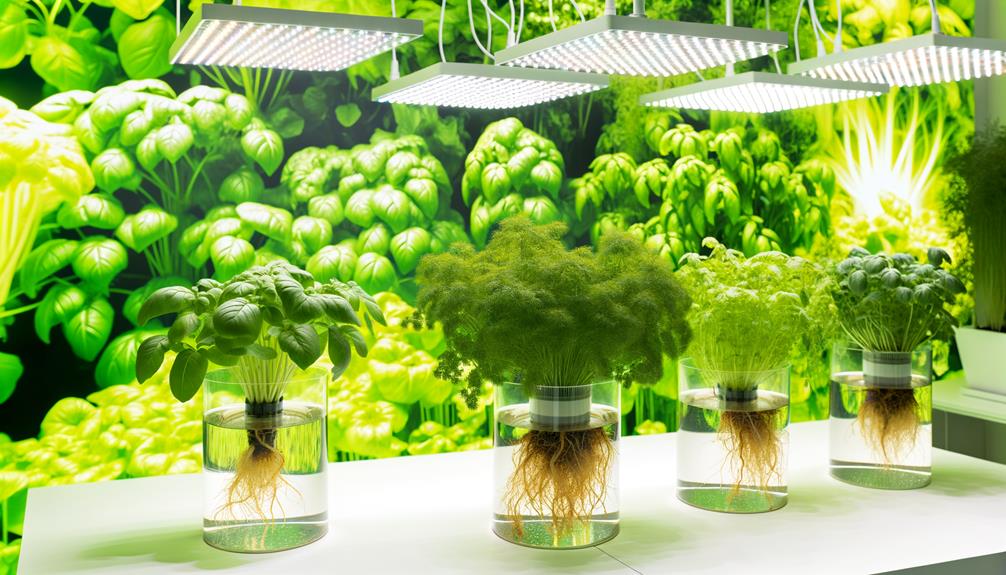
Key Takeaways
- Faster plant growth due to optimized nutrient delivery, controlled environment, and elimination of soil-borne diseases.
- Higher crop yields through precise nutrient management, vertical farming techniques, and minimized pest risks.
- Efficient water usage with closed-loop systems recycling up to 90% of water, reducing waste significantly.
- Year-round cultivation enabled by controlled light, temperature, and humidity, ensuring continuous production and higher yields.
Faster Plant Growth
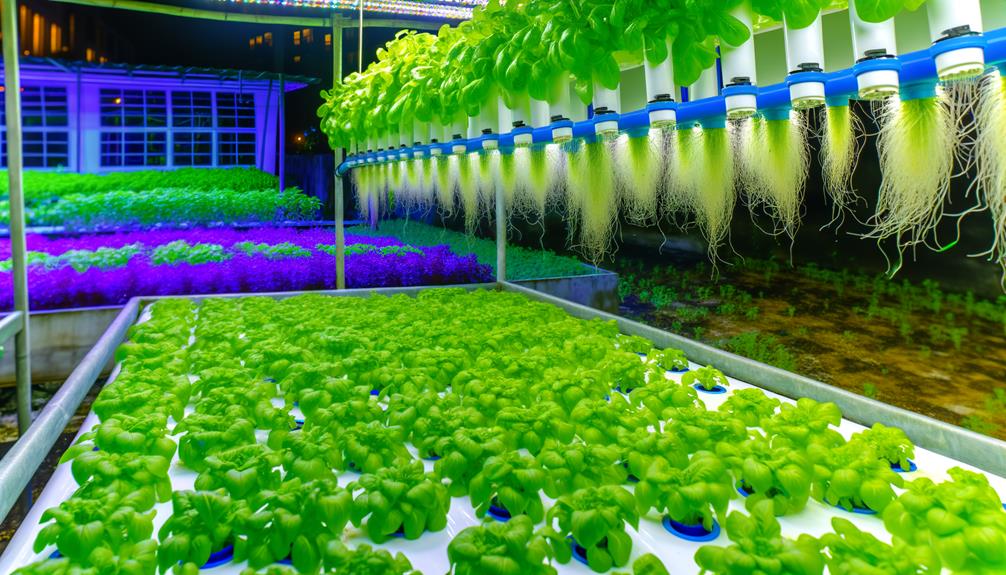
Accelerating plant growth is one of the primary advantages of hydroponic systems due to optimized nutrient delivery and controlled environmental conditions.
We can fine-tune the nutrient mix to match the specific needs of each plant, ensuring they receive the exact elements required for rapid growth.
By maintaining ideal temperature, humidity, and light levels, we create an environment where plants thrive without the stressors found in traditional soil-based agriculture.
This precision allows us to reduce the time plants need to reach maturity, effectively shortening growth cycles.
Implementing hydroponics, we eliminate soil-borne diseases and pests, further enhancing growth rates.
This synergy of controlled variables and tailored nutrients propels plant development, making hydroponics a superior method for cultivating crops swiftly and efficiently.
Higher Crop Yields
By optimizing nutrient delivery and environmental controls, hydroponic systems not only accelerate plant growth but also markedly boost crop yields.
We achieve this through precise management of nutrient solutions, ensuring plants receive balanced and consistent nutrition.
Unlike traditional soil-based agriculture, hydroponics allows us to fine-tune variables such as pH levels, oxygen content, and light exposure, creating ideal conditions for maximum productivity.
Controlled environments minimize the risk of pests and diseases, reducing crop loss and improving overall yield consistency.
Additionally, the ability to grow crops vertically or in stacked layers maximizes space utilization, leading to higher output per square foot.
This advanced approach to agriculture promises a sustainable means to meet the growing food demands of our rapidly urbanizing world.
Efficient Water Usage
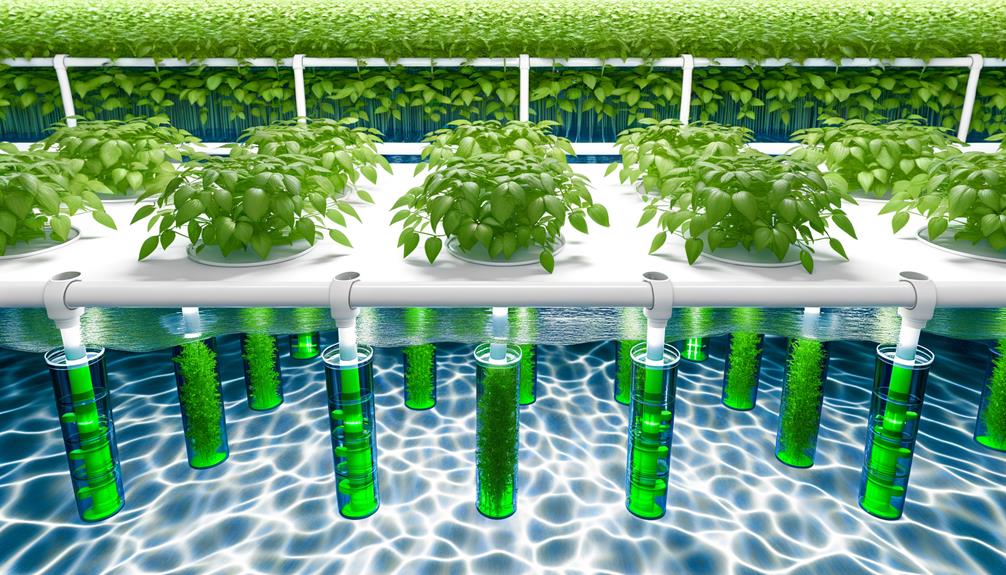
When we use hydroponic systems, we greatly reduce water waste compared to traditional soil-based methods.
By controlling the water supply, we guarantee that plants receive the exact amount they need, minimizing excess and evaporation.
This precision leads to more efficient resource usage and promotes sustainability in agriculture.
Reduced Water Waste
Hydroponics greatly minimizes water waste by recycling and reusing water within a closed-loop system.
By employing this method, we're able to use up to 90% less water compared to traditional soil-based agriculture.
The precision of nutrient delivery through water guarantees that plants receive only what they need, reducing excess runoff and evaporation.
Sensors and automated systems monitor water levels and quality, optimizing usage and minimizing waste.
This efficiency is vital in areas facing water scarcity, allowing us to grow crops sustainably.
Additionally, the closed-loop system reduces the risk of contamination, guaranteeing cleaner water cycles.
Controlled Water Supply
Our hydroponic systems allow us to meticulously control water supply, guaranteeing plants receive the exact amount needed for ideal growth. By using sensors and automated systems, we monitor moisture levels and nutrient concentrations in real-time. This precision reduces water waste and optimizes resource usage, leading to higher efficiency and sustainability.
Here's a comparison of water usage in traditional farming vs. hydroponics:
| Farming Method | Water Usage per Plant | Efficiency Rate |
|---|---|---|
| Traditional Farming | 200 liters | 40% |
| Drip Irrigation | 100 liters | 60% |
| Hydroponics | 20 liters | 90% |
As evident, hydroponics dramatically cuts water usage while enhancing efficiency. This controlled approach not only conserves water but also guarantees plants are consistently nourished, promoting robust growth and higher yields.
Space-Saving Design
In hydroponics, we can optimize space by utilizing vertical growth systems, which allow plants to grow upwards rather than spreading out horizontally.
This method's lack of soil requirements further reduces bulk and enables more compact setups.
Additionally, the reduced water usage inherent in hydroponic systems supports sustainability while maximizing limited space.
Vertical Growth Potential
Leveraging vertical growth potential, hydroponic systems maximize space efficiency by allowing plants to thrive in stacked layers. By utilizing every cubic inch, we greatly increase yield per square foot. This innovative approach is particularly beneficial in urban environments where space is a premium. Hydroponic setups allow us to grow more in less space, providing a sustainable solution for food production.
| Feature | Benefit |
|---|---|
| Stacked Layers | Maximized space utilization |
| Controlled Environment | Enhanced plant growth |
| Efficient Water Use | Reduced resource consumption |
| Urban Suitability | Feasible in limited spaces |
| Scalability | Flexible expansion capabilities |
Our systems' vertical design not only optimizes spatial efficiency but also integrates seamlessly with controlled environments, ensuring consistent and high-quality yields. This adaptability and efficiency make hydroponics an ideal choice for modern agricultural practices.
No Soil Required
By eliminating the need for soil, hydroponic systems not only save space but also streamline the cultivation process.
Without soil, we can employ vertical stacking and modular designs, maximizing our use of limited areas. This space-saving advantage is essential for urban environments where traditional farming isn't feasible.
Additionally, hydroponic systems allow for precise control over nutrient delivery. We can guarantee plants receive ideal conditions for growth, enhancing yield and reducing waste.
The absence of soil also minimizes issues such as soil-borne diseases and pests, further simplifying maintenance.
Reduced Water Usage
In addition, hydroponic systems greatly reduce water usage by circulating and reusing nutrient solutions, making them an eco-friendly alternative to traditional farming.
We can achieve up to 90% water savings compared to soil-based cultivation. This efficiency stems from the closed-loop system, where plants absorb only the required amount of water, and the excess is recaptured and reused.
The precise control over water and nutrients minimizes waste and optimizes plant growth.
Moreover, hydroponics' space-saving design allows for vertical farming, maximizing yield per square foot. By stacking plants vertically, we utilize less land area, facilitating urban agriculture and reducing the need for expansive farmland.
This innovative approach is essential for sustainable, resource-efficient food production.
Year-Round Cultivation

Hydroponic systems enable us to maintain ideal growing conditions, ensuring consistent, year-round cultivation regardless of external weather patterns. We achieve this by controlling key variables such as light, temperature, humidity, and nutrient delivery.
Advanced sensors and automation technologies allow us to monitor and adjust these factors in real-time, optimizing plant growth cycles. This continuous cultivation model leads to higher yields and more predictable harvests, essential for meeting market demands.
By eliminating seasonal dependencies, we can produce crops that traditionally wouldn't thrive in certain climates. Additionally, hydroponics reduces the need for arable land, making it a sustainable solution for urban agriculture.
Our ability to grow fresh produce consistently, without interruption, offers a significant advantage over conventional farming methods.
Reduced Pest Issues
How do we greatly reduce pest issues in hydroponic systems, thereby minimizing the need for chemical pesticides? By cultivating plants in a controlled, soil-free environment, we eliminate many vectors that traditional soil-based farming can't avoid. This leads to fewer pest infestations.
Key strategies include:
- Controlled Environment: We tightly regulate temperature, humidity, and light, creating conditions unfavorable for pests.
- Isolated Systems: Without soil, pests have fewer places to hide and reproduce, reducing their overall population.
These measures enhance plant health and yield, offering a sustainable approach to modern agriculture.
Less Chemical Usage
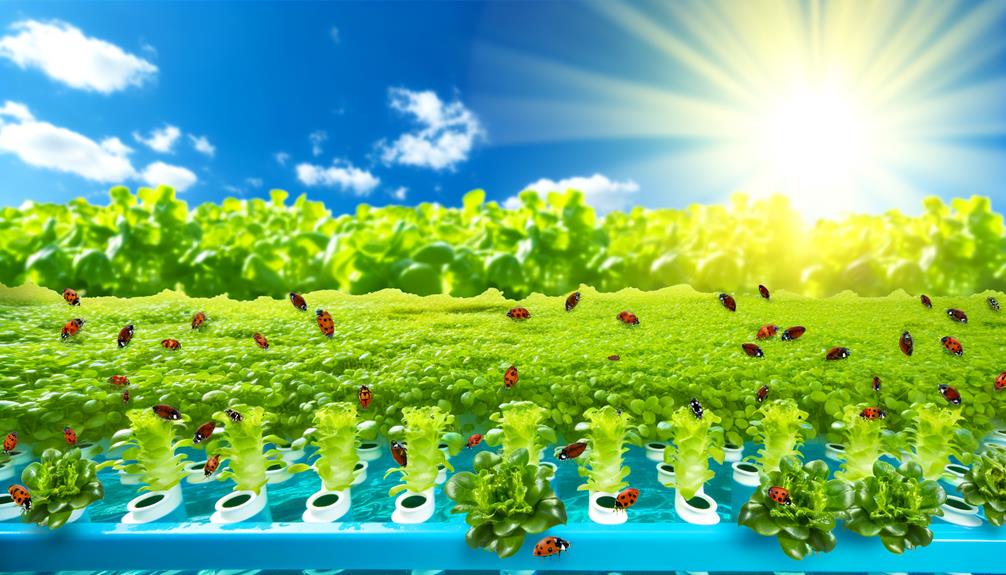
By considerably reducing pest issues through controlled environments and sterile media, we also minimize the necessity for chemical pesticides, leading to less chemical usage overall. This aligns with our commitment to sustainable practices.
In hydroponics, the absence of soil eliminates soil-borne diseases, reducing the reliance on fungicides. We achieve peak plant health through meticulous monitoring and precise environmental control.
This technological advancement allows us to target problems at their source, preventing widespread infestations. Consequently, we reduce our environmental footprint and produce cleaner crops.
Our system's efficiency is further enhanced by the utilization of integrated pest management (IPM) strategies, which prioritize biological controls over chemical solutions. This method guarantees healthier produce with minimal chemical residues.
Better Nutrient Control
We can achieve better nutrient control through hydroponics by precisely adjusting nutrient concentrations.
This precision enables us to optimize plant growth rates and overall health.
As a result, we see enhanced yields and more efficient use of resources.
Precision Nutrient Delivery
In hydroponics, growers achieve superior nutrient control by delivering precise concentrations of nutrients directly to plant roots. This precise nutrient delivery guarantees that plants receive the exact nutrients they need at each growth stage, maximizing their health and productivity.
We can tailor our nutrient solutions to meet the specific requirements of different plant species, promoting ideal growth conditions.
Key advantages include:
- Minimized Nutrient Waste: Exact nutrient delivery reduces excess, lowering costs and environmental impact.
- Enhanced Plant Health: Precise nutrient formulations prevent deficiencies and toxicities, guaranteeing robust plant development.
Enhanced Growth Rates
Enhanced nutrient control in hydroponics translates directly to accelerated plant growth rates, as plants access ideal nutrient levels consistently.
We can fine-tune nutrient solutions to match the exact needs of each plant species. This precision minimizes nutrient wastage and guarantees peak absorption. Unlike soil-based systems, hydroponics eliminates nutrient imbalances caused by soil degradation.
Roots are exposed to a perfectly balanced, oxygenated nutrient solution, enhancing their uptake efficiency. Additionally, we can monitor and adjust pH levels in real-time, further refining conditions. This controlled environment reduces plant stress and accelerates development.
Improved Food Security
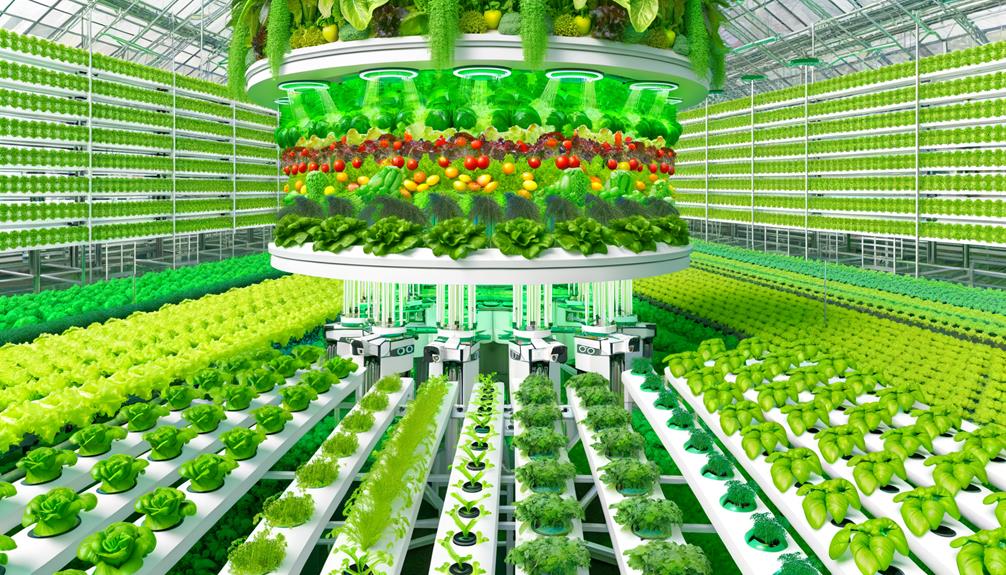
By utilizing hydroponic systems, we can greatly bolster food security through efficient resource use and year-round crop production.
Hydroponics allows us to maximize space and water efficiency, essential in regions with limited arable land. The controlled environment mitigates the impact of adverse weather conditions, ensuring consistent yields. This technology also minimizes the risk of soil-borne diseases and pests, reducing crop loss.
Key advantages include:
- Space Efficiency: Vertical farming techniques optimize limited space.
- Water Conservation: Hydroponics uses up to 90% less water than traditional agriculture.
Environmental Benefits
Through hydroponics, we greatly reduce the environmental footprint of agriculture by conserving water and eliminating the need for chemical pesticides and herbicides. Hydroponic systems use up to 90% less water than traditional farming, making them highly efficient. Additionally, the closed system design minimizes runoff, protecting surrounding ecosystems from nutrient pollution.
Our reduction in pesticide and herbicide use translates into fewer chemicals entering the soil and waterways. This not only preserves biodiversity but also enhances soil health over time. Moreover, hydroponics allows for precise control over nutrient delivery, reducing waste and optimizing plant growth.
| Environmental Benefit | Hydroponics | Traditional Farming |
|---|---|---|
| Water Usage | Up to 90% less | High |
| Pesticide Use | None | High |
| Nutrient Runoff | Minimal | Significant |
| Soil Health Impact | Neutral | Degrading |
| Biodiversity Preservation | High | Low |
Urban Farming Potential
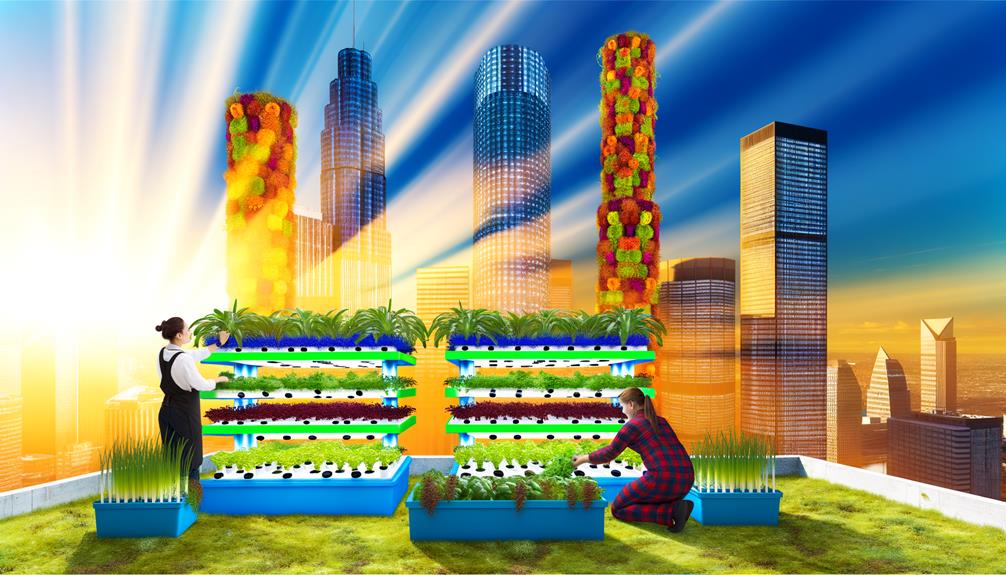
Hydroponics not only benefits the environment but also reveals significant potential for urban farming by utilizing limited space efficiently. As urban populations grow, we face increasing challenges in food production. Hydroponic systems offer a solution by enabling vertical farming, which maximizes the use of available space. These systems can be integrated into urban infrastructure, such as rooftops and unused buildings, transforming underutilized areas into productive agricultural sites.
- Space Efficiency: Vertical farming allows multiple layers of crops, optimizing limited urban spaces.
- Resource Management: Hydroponic systems use up to 90% less water compared to traditional soil farming.
Conclusion
So, we've explored the wonders of hydroponics—faster growth, higher yields, and water efficiency, all in a compact, year-round setup.
It's almost too good to be true, right? We can precisely control nutrients and enhance food security while benefiting the environment.
And let's not forget the urban farming potential.
Funny how we're solving modern problems with a technique that's been around since ancient Babylon.
Who knew advanced agriculture would bring us full circle?

